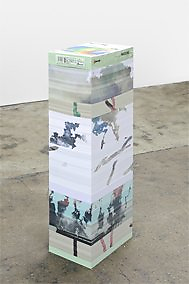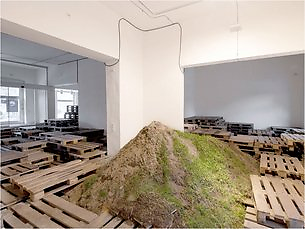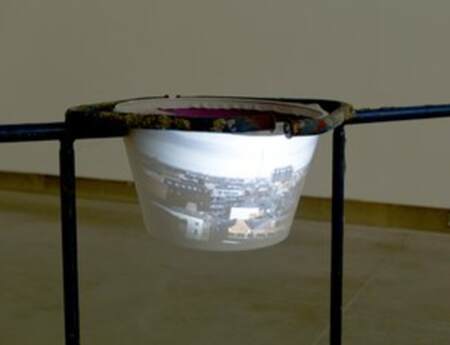Sculpture and Digitalisation
Curators' thoughts on sculpture being made in Europe today. By Nadim Julien Samman.
Today’s sculptural practice takes on the expanded technical range of representation in the digital era. These newfound capabilities have endowed us with increasingly precise control of materials, from the visible field to the particulate and the molecular. Associated with such mastery, analogues of real space – alterable to degrees unlimited by physical conditions (except processor speed) – facilitate transitions from index to remix, single to multiple, copy to version. Advances at the intersection of mechanics and chemistry mean that such virtual items can then make the move (back) into material by 3d printing, nano-technology etc.

The collapse of physicality into information – along with our redefined notions of place – mean that an object can be distributed throughout various modes of space and time simultaneously. The distinction between the model for a sculpture and the sculpture itself is increasingly vague. The age of relations between discrete entities is passing, and a practice that foregrounds the continuum is emerging.
The rhetoric of the continuum allows for the generative moment(s) of a sculpture to proceed by chemical reactions etc: Our deeper scientific understanding of material processes – such as interactions on the biological/mineral plane – underpin strategies of artist-independent object development. They also suggest a wider temporal (and hence spatial) frame – perhaps accounting for a turn towards pre-historical, archaeological, geological and cosmic themes. Such fields are suggestive of organic complexity, messiness, and ungraspability, offering a useful foil to pit against the hygienic and functionalist techno-fetishism of mainstream digital culture.

The Curator’s selection of artists whose work illustrate the described idea on sculpture:
Timur Si-Qin (Berlin, 1984)
Aleksandra Domanovic (Novi Sad, 1981)
Julian Charriere (Morges, 1987)
Antoine Renard (Paris, 1984)
Daniel Keller (Detroit, 1986)
Katie Paterson (Glasgow, 1981)
Spiros Hadjidjanos (Athens, 1978)
Das Numen:
Andreas Greiner (Germany 1979)
Julian Charrière
Felix Kiessling (Germany, 1980)
Markus Hoffmann (Germany, 1982)
Nadim Julien Samman
Nadim Samman is a curator born in the United Kingdom based in Berlin. He read Philosophy at University College London before completing a PhD in Art History at the Courtauld Institute of Art.
Beyond Import Projects, Samman’s international curatorial portfolio includes numerous exhibitions in Russia, Italy, the United Kingdom, Switzerland, Germany, Morocco and Austria.
Recent highlights include the 4th Marrakech Biennale, One of a Thousand Ways to Defeat Entropy – an Official Collateral Project of the 54th Venice Biennale – and A Positive View (Somerset House, London), under the Patronage of HRH Prince William.
Samman is a frequent public speaker, at venues that have included the Institute of Contemporary Art, London, the 798 Beijing Biennale, Christies, the Museum of Modern Art, Warsaw, and others.
A member of the International Association of Art Critics (AICA), he has written for publications such as The Art Newspaper, Art Review, Contemporary, Asian Affairs, Art India, Artchronika, Erotic Review and Dazed & Confused.
In 2011 Samman founded Import Projects ev., a non-profit platform for contemporary art and culture in Schoneberg, Berlin. Since then, Import Projects has quickly established a reputation as a leading voice probing the intersection of technology, identity and community – showcasing award winning international artists and pioneering voices in our post-digital landscape.
Import Project’s program has received coverage from high-profile media including Frieze magazine, ARTE, Sleek, Rhizome (New Museum, New York), Vice (Motherboard), Dazed&Confused and more. Through exhibitions, screenings, performance and symposia, as well as partnerships with organizations, including Berlin Social Media Week, Import Projects is a key player in debates concerning the parameters of art in the information age, the potential of new media, and the representation of our networked condition.
Samman is currently Curator in Residence at Thyssen-Bornemisza Art Contemporary, Vienna.
If you would like to contact Nadim Julien Samman please write to info@sculpture-network.org



